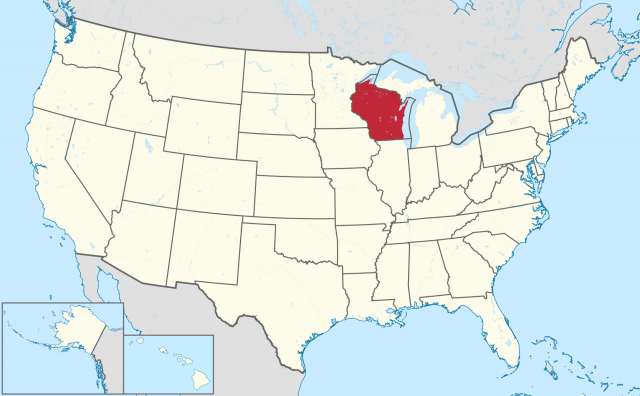Wisconsin
Wisconsin lies on the western border of Lake MICHIGAN. Covering some 65,503 square mi (169,652 square km), the state ranks 23rd overall in size. With nearly half of the state's 5,363,675 population (2000) living in five major urban areas, the state has a comfortable country feeling with approximately 44 people per square mi (114 per square km).
Madison, the state capitol, is also the second largest city (426,526 population) behind Milwaukee (1,689,572). Wisconsin is bordered by MINNESOTA and MICHIGAN on the north including a short section of Lake SUPERIOR, and by ILLINOIS on the south. To the west, Minnesota and IOWA border Wisconsin. The state is typically divided into five geographical land areas: the Lake Superior Lowland; the Eastern Ridges and Lowlands (Great Lakes Plains); the Northern Highland, or Superior Upland; the Central Plain; and the Western Upland.

As a result of glacial movement and settling during and after the last ice age, the state has more than 10,000 lakes of varying size. These range from small mountain lakes to large bodies of water such as Lake Winnebago (215 square mi or 558 square km). Interestingly, the large number of lakes and rivers account for more than 17 percent of the state's total area (11,190 square mi or 28,982 square km). The Wisconsin River, dividing the state into two distinct sections, flows generally southward across the state before turning west to empty into the Mississippi River. The rivers on the eastern side of the state, the Menominee, Peshtigo, Wolf, and Fox, flow into Lake Michigan.
Wisconsin's rich landscape of rolling forested hills and scattered lakes makes it a sportsman's dreamland, with abundant opportunities for hunting, fishing, and water sports. There are numerous state parks and several national parks, including the Saint Croix Scenic Rivers and the Apostle Islands National Lakeshore. The average elevation is 1,050 ft (320 m) above sea level, with the highest point at 1,951 ft (595 m) at Timms Hill and the lowest at 581 ft (177 m) at Lake Michigan.
Lumber has been the state's biggest resource from the very beginning. The dense white pine forests in the north and hardwoods throughout the central valleys have been irresponsibly cut in the past, but at one time they covered all but the southern plains of the state. Numerous programs of reforestation and conservation have since saved the beauty of the state and maintained the valuable lumber industry. Today, 40 percent of the state is forested and the paper-products industry in the cities of Green Bay and Appleton is one of the nation's largest.
STATE INDUSTRY
Most of the states major industries are located in Milwaukee. Here, the manufacturing of machinery, vehicles, medical equipment, and metal products rivals the meatpacking, brewing and dairy-processing industries whose origins date to the 19th century. Prior to 1965, Wisconsin had a considerable iron-mining industry in the northern parts of the state. Following the demise of iron mining, deposits of copper have been mined in the north as well as sand, gravel, stone, lime and various mineral deposits in the southwest. Wisconsin has numerous ports on the Great Lakes capable of accommodating oceangoing vessels. The harbor at Superior (shared with Duluth, Minnesota) has sizable shipyards and coal and ore docks that are among the largest in the nation.
Wisconsin has an impressive dairy industry, ranking as the nation's second-largest producer of milk, and the largest producer of cheese. Corn, soybeans, potatoes, and oats are also grown in commercial quantities in addition to many other crops. Wisconsin's shipbuilding industry flourished during World War II, and industrial growth and urbanization continued in the postwar era. Tourism and outdoor recreation are also important economic sectors.
Several hundred years ago in the roots of American history, the area of Wisconsin was famous for its fur trading. In 1686, Nicolas Perrot claimed the Green Bay region in its entirety for FRANCE. The movement of settlers in the east was also pushing various Native American tribes, including the Huron and the Ottawa into the Wisconsin area, thus displacing the older native inhabitants, the Winnebago and Kickapoo. After the French and Indian wars of 1763, Wisconsin fell to the British, who controlled the area well after the American Revolution. The British continued to dominate the fur trade in the area until the War of 1812. Definite U.S. control of the Wisconsin territory did not come until the Treaty of Ghent, when the American Fur Company took control of the industry. Ironically, the fur industry was already in a decline by that time. Fortunately, lead mining and a boom in lead prices brought a rush of immigrants who quickly realized the agricultural potential of the southern territory. The local Native Americans were quite resistant to the flood of new Americans, and were quite hostile toward the settlers. The peak of this confrontation resulted in the brutal Black Hawk War, the last serious Native American resistance in the area.
Wisconsin became a territory of the UNITED STATES in 1836 when the capital city of Madison was founded. As the population began to rise, there were several propositions for statehood, but fearing a strict government and high taxes, the people rejected them. Still, the hope lingered that becoming a state would bring prosperity and better communication and it eventually led to Wisconsin statehood (as the 30th state) on May 29, 1848. After rallying with the Union forces during the Civil War, the social and economic growth became rapid. In the 1870s Wisconsin's dairy industry began to take off, as well as the lumber industry that took advantage of the immense pine forests in the northern parts of the state.